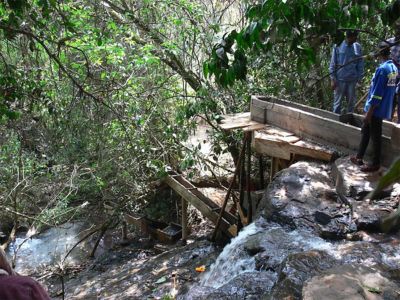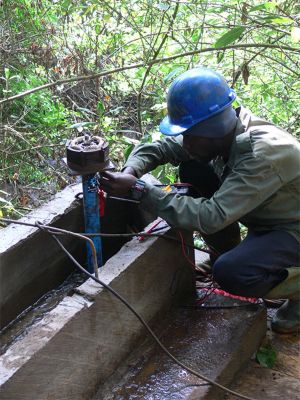-
United States -
United Kingdom -
India -
France -
Deutschland -
Italia -
日本 -
대한민국 -
中国 -
台灣
-
Ansys is committed to setting today's students up for success, by providing free simulation engineering software to students.
-
Ansys is committed to setting today's students up for success, by providing free simulation engineering software to students.
-
Ansys is committed to setting today's students up for success, by providing free simulation engineering software to students.
-
Contact Us -
Careers -
Students and Academic -
For United States and Canada
+1 844.462.6797
ANSYS BLOG
March 19, 2021
Simulation Brings Electricity to Cameroon
Cameroon is a central African country stretching from the Atlantic Ocean to Lake Chad, where approximately 26 million people live in mostly rural conditions, many without electricity. Ingenieure ohne Grenzen (Engineers Without Borders), a German not-for-profit group dedicated to improving living conditions for people in need through engineering, has used Ansys Fluent to develop a water-powered turbine to generate electricity in rural Cameroon. This not-for-profit organization was founded to solve major challenges in the less developed parts of the world using engineering. From its start in 2003, it has completed more than 160 projects worldwide.
“The special thing about Cameroon is that it is near the equator, says Maximillian Falk, a simulation engineer at Engineers Without Borders who has worked on the project. “There is a lot of hydropower potential — lots of rivers and waterfalls.”
This abundance of flowing water, at least during the rainy season, inspired Engineers Without Borders to develop a Kaplan hydroelectric turbine to place in these flowing streams. The water turns an impeller that generates electricity. The concept is simple enough, but the social and environmental conditions in the country placed additional challenges in the engineers’ way.
The Challenges of Engineering in Cameroon
When most of us think about a village, we envision a small number of houses grouped in close proximity. But in Cameroon there can be up to 3 or 4 kilometers (1.8 to 2.4 miles) between houses in what is considered a village.
“Based on these distances, what do you think is by far the most expensive part in the electrical grid we are trying to build?” Falk asks. “The wires, by almost 50%.”
Considering that the turbine is usually about 500 meters to a kilometer (a third to two thirds of a mile) away from the first house and the residual current device has to be connected with four wires, “in the best case you need at least 2 kilometers (more than a mile) of wire, which could completely destroy the budget,” Falk says. So they have to design carefully.
Another problem with distance is planning an installation. If you need to buy a new screwdriver or some other tool, it's a two-day journey to the nearest big city.
Keeping the turbine design simple, with as few materials as possible, is important so they can be easily maintained. Here, Cameroon actually gives them a unique advantage in that it has a waterproof wood that can be used for the housing of the impeller hub.
“That's actually a very nice thing,” Falk says, “because you can literally walk inside the jungle, chop a tree down and use it for several impellers.”
An impeller needs to be replaced every two years, so this readily available material makes maintenance easy.
Generating Electricity in the Dry Seasons
Cameroon experiences a short dry season from July to October and a long dry season from December to May. When the streams and waterfalls are drying up and supplying lower levels of water to the turbines, it can be hard to keep them generating electricity.
Initially, the engineers paid little attention to the design of the inlet basin of the turbine because it didn’t seem important for a device that generates just 200 watts of power. The original design was just a wooden square at the inlet to direct water to the turbine.
Two of the initial, simplified simulations.
“If the water level is low, there is a vortex behind the turbine that sucks in air, and this air increases cavitation inside the turbine and really degrades the material of the impeller,” Falk says, “so we had to somehow circumvent this. At this point we didn’t have a proper testing site in Germany.”
The only way to gather data was to speak with someone in Cameroon who had access to a test unit there. By the time this man walked to the test unit, performed the analysis and sent results back to Germany, it took a week. Based on these results, the engineers would suggest a change and wait another week — hardly an efficient development process.
This situation improved greatly when Engineers Without Borders obtained Fluent computational fluid dynamics (CFD) software and Ansys SpaceClaim, and when Falk found an old engineering paper about vortex cavitation in a Kaplan turbine in the literature. The paper suggested building a fin behind the cylinder in the inlet basin to decrease vortex shedding and make the flow more laminar throughout the turbine.
Using Fluent to simulate a sheet metal fin quickly revealed a flaw in this solution: The fin worked for air in exhaust stacks at chemical plants, but it didn’t work for water flow.
Falk and his colleagues then began using SpaceClaim to change the position and length of the sheet metal fin and Fluent to determine the resulting water flow.
“We saw that this fin allowed us to direct the water flow behind the turbine,” Falk says. The inlet water flow to the turbine comes from one direction, so parts of the turbine that are farther away from the inlet receive less water than the opening, leading to cavitation and inefficient electricity generation.
Two updated simulation animations
Using SpaceClaim and Fluent, they experimented with the angle at the end of the basin. By placing it at a 45-degree angle to the incoming water flow, it acted somewhat like a Venturi nozzle, increasing the water’s speed. This change delivered a more constant stream of water to all parts of the turbine at once, reducing cavitation and make it run much more smoothly.
“We hadn't thought about changing the angle before — it simply resulted from the simulation,” Falk says.
COVID Lockdowns and Civil War Delay the Project for Now
Engineers Without Borders managed to make one expedition to Cameroon before COVID hit, during which they installed four 200-watt turbine generators to supply electricity to rural villagers. The person in Cameroon responsible for keeping the turbines running is in COVID lockdown now and Cameroon is also in the middle of a civil war, so it’s difficult to continue with the project onsite.
But with Ansys simulation software available in Germany where they work, the engineers have been continuing to make improvements to the hydroturbine design by running simulations that have increased the power output to 350 watts and have dealt with silt buildup problems in the turbine and other challenges.
Engineers Without Borders is funded solely by donations, so if you want to see other projects they are working on and contribute to their efforts, visit their website. The organization also has chapters throughout the world.
Watch the video below for more information.














